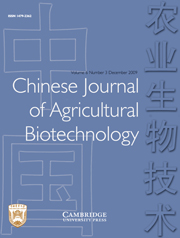Article contents
Cloning and characterization of the light-inducible Gacab promoter from Gossypium arboreum
Published online by Cambridge University Press: 12 February 2007
Abstract
A 1009 bp promoter sequence of cab gene, which encodes chlorophyll a/b binding protein belonging to a class of light-inducible proteins, was cloned from Gossypium arboreum. Sequence analysis showed that it had no obvious homology with previously published cab promoters. The full-length Gacab promoter and 5′ deletions with length of 197, 504 and 779 bp were fused with gus (uid A) gene, respectively, and plant expression vectors were used for transformation of Nicotiana tabacum cv. NC89. β-Glucuronidase (GUS) histochemical assay of transgenic tobacco plants showed that GUS was expressed specifically in leaves and young green tissues. GUS was not detected in the leaves of transgenic plants grown in the dark for 6 days. However, it was highly expressed in the leaves of these plants after induction with light for another 6 days, demonstrating that the full-length Gacab promoter is a light-inducible promoter. Transient GUS expression in rice calli indicated that the expression level of Gacab504::gus was the highest and stronger than that of the CaMV 35S promoter, while expression was reduced for Gacab197::gus, Gacab779::gus and Gacab1009::gus constructs. This suggests that −197 bp to −1 bp is a basic promoter of Gacab, some positive regulatory elements may exist in −504 bp to −197 bp, and the fragment −1009 bp to −504 bp may contain negative elements.
Keywords
Information
- Type
- Research Article
- Information
- Copyright
- Copyright © China Agricultural University and Cambridge University Press 2005
References
- 4
- Cited by

